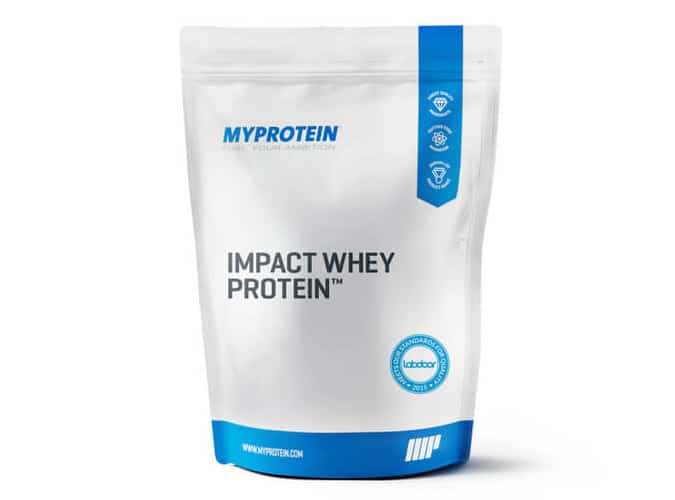The sports supplement market is currently an £8 billion ($10 billion) industry. And with everything from powders and drinks to snack bars and even ice creams upping their protein content, increasing your intake is now marketed as a shortcut to wellness. So, where the hell do you begin?
Even if you were to jettison the latest tonics in favor of powders alone, how then do you decide which protein source to go for? Hemp? Soy isolate? Vegan-friendly pea protein?
To help you out, we ask the experts to whey in and break down the protein powder industry into the bare facts. Which one is right for you? How often should you take it? And what do they actually do? In short, this is how to add bulk to body and brain.
Why Do I Need Whey Protein?
You might know taking protein is what people do when they’re trying to get that Henry Cavill physique, but how exactly does it work?
“When you eat it, protein synthesis rates rise in your body,” says James Castle-Mason, a trainer at London’s high-end Roar Fitness gym. Once protein levels are high enough to prevent your body breaking down muscle for fuel (catabolism), you’re then able to use the excess protein to build muscle (anabolism). Simple, right?

Supplementing your diet with whey protein powders in a shake is a reliable way to ensure you continue to grow and recover, instead of losing muscle mass after a workout. But it’s not the only option.
“Whey protein, is a high-quality, fast digesting, soluble protein found in milk whey,” explains Harley Street nutritionist Rhiannon Lambert. “It is formed through clotting and is the remaining component once coagulation and curd removal has occurred during cheese manufacturing.”
In other words, it’s slightly gross. However, when it comes to getting ripped and repairing muscle, there’s nothing quite like it. “Whey is a complete source of protein, meaning it contains all nine essential amino acids,” she adds. These essential amino acids are required to make new protein in our bodies. And while our bodies can produce some of them, we need to get the rest from poultry, fish or other sources. A protein source containing all essential amino acids is known as a ‘complete protein’. As a complete source, whey powder immediately makes it easier to up your intake.
Another term frequently plastered over protein supplement packaging is ‘BCAAs’. This is just an easier way of talking about the protein-building blocks of amino acids and stands for ‘branch-chain amino acids’. As well as being important for muscle maintenance (making sure you don’t lose mass during a heavy cardio workout, for example), they can also help you recover more quickly after a hard session, reducing inflammation and risk of injury. Evidence has also shown that higher-protein diets can promote muscle gain and help prevent the loss of mass that naturally occurs as humans age.

Are There Different Types Of Protein?
There are a lot of different protein sources out there. Whey tends to be the most popular, but of course, if you’re vegan or just want to cut down on your involvement in the meat and cheese industry, it might not be the best option for you. Fortunately, there are alternatives, each with their own benefits.
Soy can increase dietary protein just like whey, and is also a complete protein. Though some studies suggest it is not as effective at changing body composition.
Casein is slow releasing, which is why it’s often used overnight to deliver a gradual supply of protein while you sleep. Some studies have found lower levels of BCAAs and muscle protein synthesis in casein when compared to whey, so a combination of both is suggested.
Hemp is not technically a complete protein because it is low in lysine and leucine (two amino acids), but it does have a high fibre content and is a source of omega 3 and 6. However, there is little research on hemp protein compared to other sources.
Pea also suffers from limited evidence into its usefulness. However, it does contain more arginine (a particular amino acid) than whey, which is particularly good for building muscle.
Blends are usually a mix of hemp, pea and brown rice protein. These may be higher in carbohydrates if made cheaply, which can lead to weight gain – but not the sort you want. Blends may also be disguised, for example, they might be a blend of whey isolate and concentrate, which means a lower protein content than a complete whey protein isolate. It may also mean it might contain more stabilisers, mixers and flavorings.
“Whey protein is predominantly used by individuals who partake in resistance exercise (e.g. bodybuilding), as the goal is often to increase muscle mass,” says Lambert. “Whey protein is useful because it is thought to stimulate muscle protein synthesis to a great degree, especially in comparison to other protein sources such as soy.”
When Should I Take Whey Protein?
“A critical window of 20 – 40 minutes exists where the muscles require an intake of nutrients to replenish protein and glycogen stores,” says Castle-Mason. “The use of post-workout protein shakes is essential for anyone participating in weight training, and a dose of 30-40 grams is widely accepted as being the optimal amount for recovery and growth.”
So, can you guzzle as much protein as you like and expect results? Sadly, no. After all, as the Rocky film series taught us, there are no shortcuts to success.
“Whey protein in isolation cannot cause muscle gain, although, in combination with a calorie surplus and exercise, it can provide a fast and easy way of ensuring an athlete or active individual has enough protein in their diet to increase mass,” says Lambert.
In other words, you need to be moving every day. Take protein powder after exerting minimal effort, and the calories in it are likely to settle around your middle, rather than your arms. Take protein as part of a carefully thought-out exercise plan combining weightlifting, diet, and cardio, and you’ll soon start to see results.

Can Protein Powder Replace A Meal?
Though some
To begin with, 30g of protein often only contains 120 calories at most, which is far less than a meal should (300-600 calories is typical, depending on body type, time of day and activity level). This doesn’t mean protein shakes are good for people trying to lose weight either. The clue is in the name: a protein shake contains lots of protein, but very little of the vitamins, minerals, fibre and other beneficial elements that we get from real food.
“It is never safe to replace a meal with a shake,” says Lambert. “Not only do protein shakes lack the fibre that a meal will have, they also have little to no micronutrients. And although protein is satiating (makes you feel full), carbohydrates and fats are both equally as important to fuel the body efficiently. Protein shakes are fine to incorporate into a diet, but should not be used as a meal replacement.”
In other words, replacing meals with protein shakes may seem like a shortcut to gains, but you’ll only be damaging your progress – and health – in the long term. Fat, carbohydrates and protein form the three macronutrients all humans need, and cutting out one in favor of the other is a mistake. In fact, the ideal dietary ratio is 50 percent carbohydrates, 20 percent protein, and 30 percent fats. Clearly, then, to overload on the protein would be a mistake. Up your protein intake in line with your exercise, by all means, but make sure you keep your other macros consistent, too.

Are There Any Negatives To Using Protein Powder?
“Although whey can be extremely convenient when it comes to a fast protein source, there are some reported side effects,” says Lambert.
The positives of whey powder include fast absorption of protein, convenience, and adaptability — stick it in your pancakes, porridge, or in a shake.
The downside is that whey protein can exacerbate pre-existing liver or kidney conditions, although, Lambert points out, this is rare. Additionally, it pays to check the sugar content of your powder. Some brands contain added sugar and artificial sweeteners, which not only lowers the powder’s micronutrient composition but can up the price, too.
What About Protein Bars And Other Supplements?
Remember: just because a label shouts about protein content, it doesn’t mean the product is particularly healthy. Many of those protein bars found at supermarket checkouts are packed full of sugar, and wolfing down too many is an easy way to increase cravings for other sweet products, such as chocolate bars.
“Protein bars are usually very expensive, and they’re used as a tool to tempt people into thinking they’re healthier than a chocolate bar,” says Lambert. “In reality, it might be more sensible to have something small and sweet after the normal meal consumed which contains protein e.g. fruit and a few squares of dark chocolate or nut butter.”
Likewise, because 30g of protein is ideal post-workout, you don’t really need to have a protein bar with 20g of protein in it as well. “It may be more sensible to look for a protein bar or ball that uses oats or nuts and doesn’t list too many ingredients,” adds Lambert. “It may be lower in protein than your average protein bar, but it probably tastes better, contains more fibre and has higher quality ingredients.”

What Should I Look For In A Protein Powder?
The most important thing to consider when choosing a protein powder isn’t the flavor. Instead, it’s the ratio of protein and carbs per 100g. “This is usually the best clue as to its purity,” says Castle-Mason. “Ideally, it should contain a single type of protein rather than a mix of different types – this is a sign of the company not cutting corners.
“Certain ingredients such as BCCAs and glutamine are desirable, but beware of protein powders with long ingredient lists, or the phrase ‘propriety blend’. If you want to add other supplements for your workout, it’s generally better to buy them individually from a reputable brand where you know they are well sourced and of a decent quality.”
As a general rule, the lower the percentage of protein, the more likely the powder is to have additional and perhaps unwanted ingredients including, sugars and sweeteners adds Lambert. “The percentage of protein does not include the amino acid profile, so 75 percent protein suggests a very good yield. But do check the amino acid profile: ideally, you want to ensure the protein is complete, meaning it contains all essential amino acids.”
The Best Brands For Whey Protein
Optimum Nutrition Gold Standard Whey
This heavy lifter is high-quality, low-carb, great value and tastes ace, too, coming in a rich chocolate flavor. It is also low in lactose and has no additional fillers. So, win-win.
MyProtein Impact Whey
Available at bargain prices, this isn’t as high in protein as some of the others mentioned. But, if you are on a budget, it’s a tasty, no-nonsense alternative available in over 50 flavors.
Maximuscle Whey Protein Isolate
Packing in 23.5g of muscle-forming protein per serving, this powder only has 1.9g of carbs per serving, meaning you’ll gain enough to replenish your muscle’s energy stores, but won’t gain flab around your middle.
Bulk Powders Pure Whey Protein
The best feature of this powder is that it’s available in 200g to 3kg bags, meaning you needn’t invest needlessly if you’re giving whey protein a try for the first time, nor do you have to stock up on lots of smaller packets if you’re a certified gym-nut.
BioTechUSA IsoWhey Zero
A major plus for those with sensitive stomachs, this powder is lactose-free, so there’s no risk of feeling bloated after taking it. Plus, you don’t have to resort to drinking less tasty combinations such as pea, hemp or rice protein powders.












